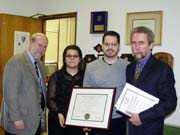Memorial High School in West New York has been accredited by the Middle States Association’s Commission on Secondary Schools for the five-year period ending Dec. 1, 2005.
“When a school is accredited, it adds some degree of validity to the education process,” said teacher Robert Wilson, who worked as one of the two internal coordinators on this evaluation.
Memorial High School has been accredited at several 10-year intervals since 1970.
The school’s evaluation process ended with a three-day visit by the Middle States evaluation team in March of last year. The team then met with students, teachers, parents, members of the town’s Board of Education and people in the community.
“It gives me great satisfaction to see our high school receive this important accreditation,” said West New York Superintendent of Schools Anthony Yankovich. “This accreditation confirms once again the quality education that West New York is providing to our children.”
West New York was notified of the accreditation in November, but was formally given the certificate in February.
Evaluating student performance
Memorial High School was one of the first schools to use the Accreditation for Growth protocol, which makes it necessary for the school to get a more vigorous evaluation.
According to Yankovich, the decision was made after a team of educators appointed by the Commission on Secondary Schools made a three and one-half-day visit to the school last spring.
When Memorial chose to use the Accreditation for Growth model, only six other schools were using that model. Now, according to Timothy Schroeder, who was Memorial High School’s principal during the evaluation, there are more than 1,000 schools using this model for accreditation.
A school must meet the commission’s standards in the areas of the school’s educational program, learning media services, student services, student activities, facilities, school staff and administration, finance, school leadership and governance and assessment of learning.
By electing to use the AFG protocol, Memorial High School had to do more than meet the normal standards set by the evaluation team. The AFG protocol uses strategic planning as a vehicle for school improvement and growth in student performance. In AFG, the determinants of progress are the actual results of the student’s performance.
“We wanted to focus on improving student performance,” said Shroeder, who is now the West New York School District principal. “We should be looking at outcomes. Not historical backgrounds.”
Ongoing improvement
While the evaluation visited the school for a three-day period in March of last year, the evaluation process began in 1998 for Memorial High School.
Wilson said that the school had to produce a complete profile of the school and the community.
To do this, the school relied of a number of internal and external surveys that were designed and scanned professionally by the National Study of School Evaluations in Chicago.
“[The school] surveyed students, parents, staff and the community,” said Wilson, explaining that a member of the community is different from a parent because the community member does not have a student in the high school.
Based on the results of these surveys, the school set goals that would allow them better student performance and community relations.
A planning committee that consisted of students, faculty, parents and community members, was created to develop three goals for the high school. The committee set three goals for the school.
First, by June, students will demonstrate an increased level of community awareness and cultural understanding. “People felt that we don’t do enough for the community,” said Schroeder.
The next two goals deal directly with the students’ academic performance. By June 2005, the school hopes that the students will increase their academic skills as tested in the HSPT and SAT tests and the school’s overall Grade Point Average; and demonstrate an increased level of technological awareness and application.
An action committee set up to determine an action plan to achieve these goals has determined 29 separate actions to help meet these goals, and an implementation team is in place now to make sure that the action plans are being met.
